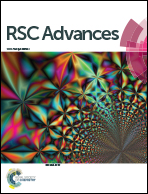One-step molten salt carbonization (MSC) of firwood biomass for capacitive carbon†
Abstract
Capacitive carbons are prepared by a molten salt carbonization (MSC) process from Chinese firwood biomass, and the effect of the biomass size (lengths ranging from 0.09 to 2 cm) on the carbon yield and the electrochemical capacitive performance of the carbonized samples is investigated. The mechanism of carbon treatment and structure–activity correlations are discussed. Compared with carbon prepared without the assistance of MS, MSC-derived carbon prepared from the same precursor size (i.e. 0.09 cm) shows a higher specific capacitance (189 vs. 165 F g−1 at 0.2 A g−1) and enhanced high-rate capability (85% vs. 70% capacitance retention upon increasing the charge–discharge current density from 0.2 to 2.0 A g−1). Upon decreasing the precursor size from 2.0 to 0.09 cm, the specific capacitance increases from 142 to 189 F g−1, with the high-rate capacitance retention increasing from 70% to 85%. These improvements highlight the merits of the MSC method and engineering the precursor sizes for the preparation and modification of enhanced capacitive carbon, which is promising for practical applications. It is also found that the production yield of the MSC method decreases upon decreasing the precursor size. Therefore, the precursor size should be prudently tailored to ensure a balance between the capacitive properties and production yield.



 Please wait while we load your content...
Please wait while we load your content...